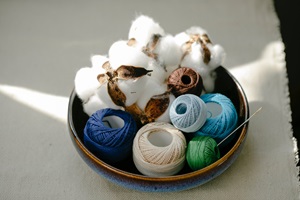Understanding HVI Cotton Test Report

Introduction
Understanding HVI Cotton Test Report
HVI parameters are used to measure the quality of cotton bales. These parameters are important for grading and sorting. The measurement process is divided into two different stages, which includes:
- First stage of HVI parameters measurement procedure involves taking an initial reading on a sample of raw material using a standardized method developed by HVI.
- Second stage involves repeating this measurement on each sampled bale in order to obtain a final value which represents the overall quality attributes of that particular batch at that point in time
1 – Mic – Micronaire
Here are some of the interesting points about Micronaire:
- Micronaire is a measure of the fineness of cotton.
- It can be calculated using the following equation:
M = D/1000, where M is micronaire; D is diameter; and 1000 is an average value for each filament diameter in millimeters.
2 – Length(MM) – Staple Length In MM
Length of staple is the length of individual fibers in a cotton bale. It is an indication of the quality of cotton. A long staple has more fiber length than a short one, which means it will be less likely to break when processed into bales or even into yarns.
3 – Strength (G/Tex)
Strength is a parameter that measures the tensile strength of the fabric. Strength is measured in g/tex, which is equal to how many grams of force can be applied to a single tex of fabric before it breaks. When you look at your garment’s label, you may see this term and wonder what it means. The answer lies within the HVI and its myriad of parameters!
As seen above, strength = Gms per Tex (or Gm/T)
4 – Elasticity %
Elasticity is a measure of the amount of energy required to stretchablility. HVI measured it in percentage.
We calculate the elasticity by using the equation:
- Original length (m) = Length after stretching (m) – Length before stretching (m).
- Extension (m) = Original length * Elasticity %/100%.
5 – Unit Weight (G/M2)
UNIT WEIGHT is the weight of the fabric per unit area. It is expressed in g/m2 and is used to calculate the price of the fabric.
6 – Trash %
Trash % is a measure of the foreign matter content in a bale. We also measure it as a percentage of the weight of the bale.
7 – GPT – Grade Progressing Trend Measurement
GPT is a measure of the quality of cotton fibre. It stands for Gram per Tex. It is also an important parameter for cotton quality. We can define it as the ratio between weight and length. GPT is a measure of the strength and elasticity of cotton fibers. It also expresses how much force it takes to break or rupture a given piece (i.e., breaking point).
8) Color grade
8 – Color grade
Color grade explains the dullness and brightness of cotton.
What is staple length in cotton?
Complete definition.
Here are a few staple lengths and their importance and definition also described for better understanding.
Staple length below 27 mm is considered short staple cotton and mostly we use it for counts below 20/1.
Major portion of global cotton consists of the staple length between the range of 27 to 30 mm fiber length. Count range mostly from 20/1 to 40/1 carded or combed for weaving or knitting.
Above this is long staple cotton with staple length 30mm to 33 mm.
ELS, or Extra-long staple cotton, refers to cotton fibers measuring 33mm or longer.
What is Uniformity Index UNF in cotton testing?
Here are the details for ideal or poor counts of Uniformity:
- A Uniformity Index below 77 is poor grade.
- Uniformity Index falling between 77 to 80 is classified as low uniformity.
- The best range of Uniformity Index from is from 80 to 84.
- Uniformity Index between the range of 85 to 87 is the best range.
- Any Uniformity Index above 87 is always the best level.
What is (SFI) Short Fiber Index In cotton HVI report.
Understanding HVI Cotton Test Report
SFI Short fiber index is a very important parameter in cotton results as it determines the ratio of short fiber in cotton. SFI indicates the %age of fiber having less than half inch length. The High Volume Instrument counts this ratio. It stands as one of the latest and best cotton testing instruments within the textile sector.
SFI below 6.00 is an indication that cotton has very little fiber which is good for cotton consumers. But this sort of cotton is rarely available.
Normally and mostly cotton contain SFI between the range of 6 to 9 and it’s acceptable for most cotton buyers.
Cotton consumers consider a SFI short fiber index ranging from 10 to 13 slightly higher, but they find it somewhat acceptable.SFI short fiber index above 14 is usually not acceptable for yarn manufacturers who want to make fine quality yarns and they avoid buying cotton with such high value of SFI.
What is Rd and +b in cotton and its definition
Both Rd and +b are the color grade parameters for cotton. Rd describes the reflectance in cotton. Higher rd indicates the brightness in cotton while lower rd reflects the dullness or grey look in cotton. Higher rd in cotton signifies superior quality, contributing to increased value and price. Additionally, +b in cotton measures its yellowness.
FAQs
What is an HVI cotton test?
The High Volume Instrument (HVI) test is a standard method used to assess the quality of cotton. It measures various physical properties of cotton fibers, such as length, strength, fineness, maturity, and color.
Why is the HVI test important?
The HVI test helps determine the quality of cotton, which is crucial for textile manufacturers, traders, and buyers. It provides detailed information about fiber characteristics, aiding in the classification and trading of cotton.
What does an HVI cotton test report include?
Typically, an HVI cotton test report includes data on fiber properties like micronaire, length, strength, uniformity, elongation, color grade, and trash content. These properties are essential for evaluating cotton’s suitability for different textile applications.
How is HVI testing conducted?
HVI testing involves feeding a sample of cotton into an instrument that measures various properties using advanced technology. The instrument analyzes the fibers and generates a report detailing the characteristics of the tested sample.
How to interpret an HVI cotton test report?
Interpreting the report requires understanding the specific parameters and their acceptable ranges based on industry standards. It’s essential to compare the test results with quality benchmarks to assess the suitability of the cotton for different applications.
Can HVI test results vary?
Yes, HVI test results can vary due to factors like the cotton variety, growing conditions, harvesting methods, and processing. Variations in these factors can lead to differences in fiber properties from one batch of cotton to another.
Who uses HVI test reports?
HVI test reports are used by cotton growers, ginners, traders, textile manufacturers, and other industry stakeholders. These reports help in buying, selling, and processing cotton based on its quality characteristics.
Are there any limitations to the HVI test?
While the HVI test provides valuable data, it may not capture all aspects of cotton quality. Some specialized properties or characteristics might require additional testing methods for thorough evaluation.
If you need more specific information about an HVI cotton test report or its interpretation, feel free to ask!
